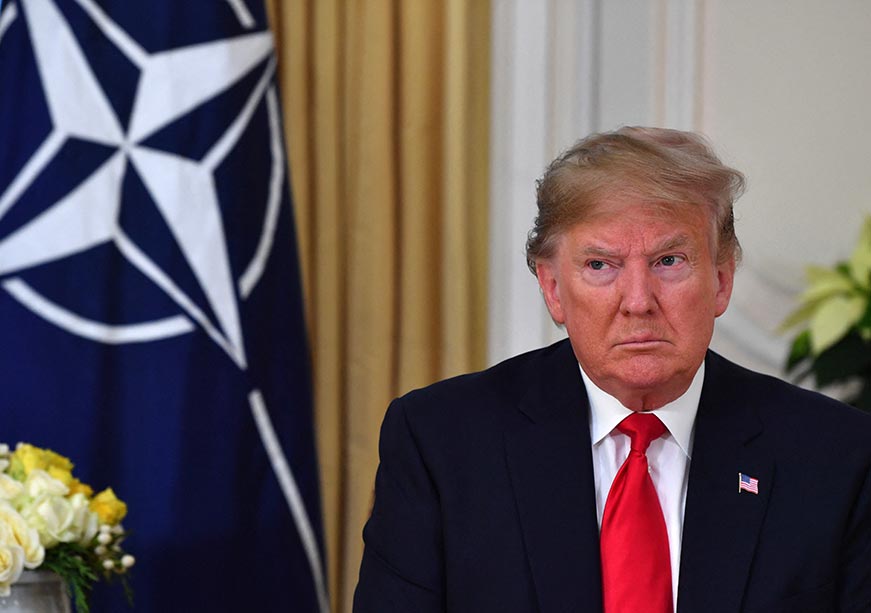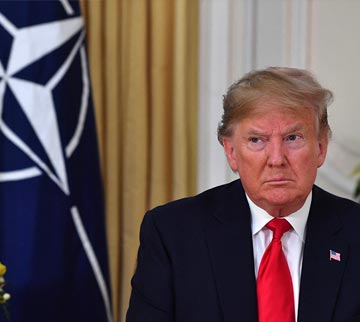
Image source: Getty
In February 2024, then-Republican presidential candidate Donald Trump expressed dissatisfaction with the 2% Gross Domestic Product (GD) defense spending target set by the European nations of the North Atlantic Treaty Organization (NATO), raising it to 3%. He appealed for the increase to %. percent. He also threatened not to extend protections to members unwilling to meet this requirement.
President Trump’s first term was dominated by a US-centric approach, and the same is expected to characterize his second term. During the Russia-Ukraine war, President Trump frequently criticized the Biden administration’s level of involvement. In a February 2024 speech, President Trump used the issue of NATO defense spending to strengthen his case that the United States would withdraw from Ukraine’s main supporter.
President Trump’s first term was dominated by a US-centric approach, and the same is expected to characterize his second term.
Old wars, old presidents
As of November 2024, President Trump’s speech is not just a possibility, but a recollection of actions from his previous term. In 2019, the Trump administration withdrew from the INF Treaty (the 1987 Intermediate-Range Nuclear Forces Treaty), leaving only the New START Treaty to address the U.S.-Russia agreement on nuclear weapons deployment. The New START Treaty has been criticized by many experts and even President Trump himself, who wants full negotiations on the new treaty and argues that the New START Treaty is not enough to limit the use of nuclear weapons. Earlier this year, Russian President Vladimir Putin claimed that Western aid to Ukraine in the form of long-range missiles could lead to a Russian nuclear response. Although many US policy experts have criticized this as an almost impossible outcome, Putin’s comments may have shaped US sentiment toward withdrawal.
The New START Treaty has been criticized by many experts and even President Trump himself, who wants full negotiations on the new treaty and argues that the New START Treaty is not enough to limit the use of nuclear weapons.
A potential U.S. withdrawal from Ukraine would have a direct impact on European powers, forcing countries like Germany to take on a more visible role and contribute to the defense budget, which they have so far been reluctant to do, and to encourage intra-European alliances and It would strain the unity within NATO. Russia’s nuclear posture will exacerbate tensions within NATO and between the European Union and the United States. The former Trump administration threatened to withdraw from NATO. Although this did not happen, the unrest over the withdrawal demonstrated to competing world powers such as China and Russia that NATO and the United States do not function independently. The EU and NATO may come under increasing pressure to strengthen their military, which could increase geopolitical differences both within Europe and with the United States. At its 75th anniversary summit in July 2024, NATO attempted to state its position on Russia. But continued dependence on the United States and reluctance to make Ukraine a full member state are hampering these efforts.
Nuclear Posture and NATO
At the 2024 Summit in Washington, DC, NATO reaffirmed its position on nuclear weapons and development, stating that nuclear weapons are an instrument of international security and deterrence, particularly in response to the Russia-Ukraine war. Identified. As mentioned above, Russia has also reaffirmed its intention to use nuclear weapons. Russia and NATO states mentioning the possibility of using nuclear weapons only shows that the Nuclear Non-Proliferation Treaty (NPT) and its attempts to contain nuclear proliferation are far from successful. Furthermore, Finland and Sweden’s membership in NATO may also have an impact on the NPT. So far, these countries have left the alliance with nuclear weapons. Although neither possesses nuclear weapons, they are currently members of NATO and under the protection of its nuclear umbrella. With this accession, these new member states will be required to strictly adhere to a defense spending limit of 2% (of GDP).
Russia and NATO states mentioning the possibility of using nuclear weapons only shows that the Nuclear Non-Proliferation Treaty (NPT) and its attempts to contain nuclear proliferation are far from successful.
President Trump’s longstanding criticism of NATO and European military spending has had a lasting impact on transatlantic relations. Nations such as France and Germany may further develop autonomously operating military systems, potentially leading to a different approach in how NATO responds to security threats. Furthermore, President Trump’s support for a more hawkish stance toward European military forces could trigger a reassessment of Europe’s dependence on the United States for military deterrence.
Reaffirming NATO and strengthening nuclear security
Rather than withdrawing or reducing its participation in NATO, the United States should take a more pragmatic approach to the region and reinvigorate the alliance’s defense posture, ensuring that nuclear deterrence is strong and in a modern security environment. It can be ensured that it remains compliant. The next presidential term is an opportunity to reinvigorate our relationships with our NATO partners and reaffirm our commitment to collective defense and nuclear security.
Additionally, the United States can and should be at the forefront of arms control support, particularly because of nuclear risks to Europe and West Asia. President Trump’s “maximum pressure” campaign against Iran has led to significant tensions, particularly with Turkiye, but a more balanced approach that combines deterrence and diplomacy would be more successful. Therefore, by maintaining relationships with the United Kingdom, France, and Germany, which are already working on this issue, the United States can address the nuclear threat posed by Tehran and thereby contribute to restoring stability in the region. The United States must continue to abide by arms control treaties, including the aforementioned New START Treaty between the United States and Russia, and continue to lead efforts to prevent the proliferation of nuclear weapons through international mechanisms.
The United States must reaffirm the importance of collective defense and nuclear deterrence and continue its engagement with NATO and its allies while advancing efforts to prevent further nuclear proliferation and reduce the risk of catastrophic conflict. No.
In a changing geopolitical landscape in which new nuclear powers emerge and state and non-state actors challenge the alliance, NATO not only reboots its nuclear posture but also strengthens its common security, diplomatic and military arsenals. It is necessary to mobilize member states on a management basis. The United States must reaffirm the importance of collective defense and nuclear deterrence and continue its engagement with NATO and its allies while advancing efforts to prevent further nuclear proliferation and reduce the risk of catastrophic conflict. No. President Trump’s policies in his first term clearly changed NATO’s defense and nuclear security strategy by essentially weakening the alliance. The foundations of a stable and secure international order require that NATO remain resolute and able to respond to traditional and nuclear threats. Rather than retreat, the United States should reaffirm its commitment to NATO, strengthen nuclear security efforts, and seek to work with allies to address emerging threats.
Shravishtha Ajaykumar is an Associate Fellow in the Center for Security, Strategy, and Technology at the Observer Research Foundation.
The above views belong to the author. ORF research and analysis is now available on Telegram. Click here to access our carefully selected content (blogs, long-form articles, interviews).


